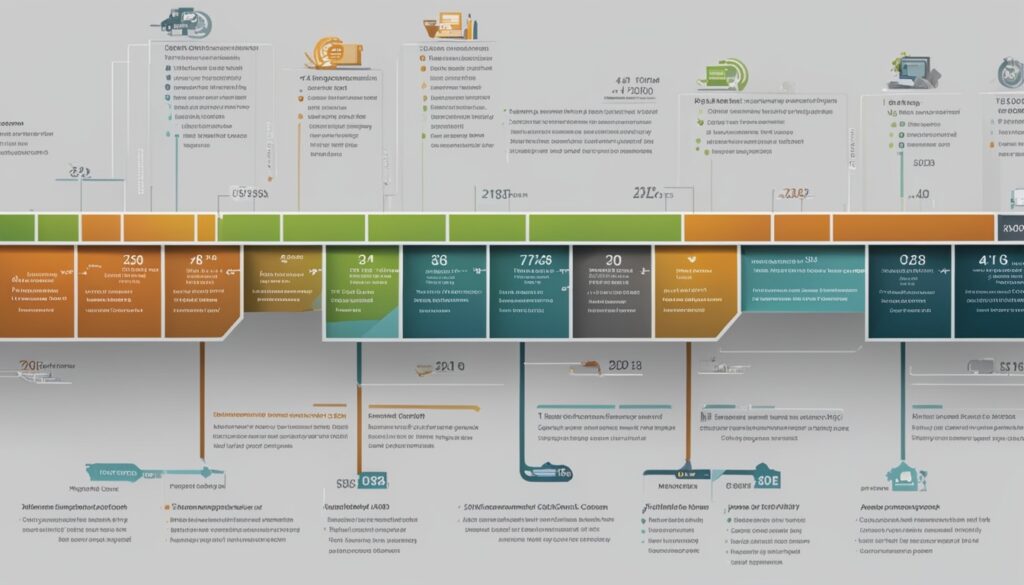Ever thought there might be a better way to handle costs in your Philippine business? Traditional accounting methods can miss crucial details needed for smart financial decisions. Here’s where Activity Based Costing (ABC) shines.
ABC changes the game in accounting. It looks closely at how costs are connected to different activities. By doing so, it shows exactly how each action affects what you spend. This helps businesses in the Philippines to wisely tweak their operations and improve their money matters.
Interested in how Activity Based Costing could help your business in the Philippines? Let’s explore this tailored cost management strategy further.
Key Takeaways:
- Activity Based Costing (ABC) offers a more accurate and detailed approach to cost management for businesses in the Philippines.
- ABC helps identify and allocate costs based on the activities that drive them, providing a clearer view of how each activity impacts operating costs.
- By adopting ABC, businesses can optimize their cost management practices and enhance financial efficiency.
Understanding Activity Based Costing in the Philippine Context
In the Philippines, small and medium-sized businesses (SMEs) need to focus on cost management. One method helping them is Activity Based Costing (ABC). ABC links costs to specific activities, unlike older methods. This makes it an important tool for business management.
What Is Activity Based Costing?
Activity Based Costing (ABC) assigns costs by looking at the activities that use resources. This is different from older ways of looking at costs, which were more general. ABC helps businesses see the real cost of their products or services by focusing on what each activity needs.
The Need for Activity Based Costing in Philippine SMEs
In the Philippines, SMEs need to manage costs to stay competitive and grow. ABC is a great fit for Filipino businesses because it tracks costs closely to activities. This helps SMEs find and fix inefficiencies, use resources better, and focus on what really adds value.
Comparison with Traditional Costing Methods
Older costing methods like job order or process costing don’t fit well with today’s business world. They often give a general picture of costs. Meanwhile, ABC digs deeper, showing the real use of resources. By using ABC, Filipino SMEs can get ahead in managing costs better than before.
Unveiling the History of Activity Based Costing
The story of activity based costing (ABC) starts in the 1950s in the US. Its big break came in the early 1990s. Professors Robert Kaplan and Robin Cooper led the way. They saw the flaws in old ways of figuring out costs.
Businesses were changing fast back then. New ways of making things and more competition meant old methods of figuring out costs didn’t work anymore. Managers couldn’t make good choices without knowing where the money was really going.
Kaplan and Cooper showed that costs should link to the activities behind them. They called this a ‘revolutionary’ idea. It was all about seeing exactly what it takes to make each product or service.
ABC also got a boost from new technology. Computers and special software made it easier to track costs accurately by linking them to what really causes them.
Now, ABC is a key tool for all kinds of businesses, even in places like the Philippines. It helps them understand their expenses better. This means they can find ways to spend less and make smarter choices.

The Need for Activity Based Costing in Philippine SMEs
In the Philippines, small and medium-sized businesses (SMEs) are very important. But they often find it tough to keep costs in check. Old ways of tracking costs don’t always show the whole picture.
Activity based costing steps in to help. It breaks costs down in a detailed way. This helps Philippine SMEs see what’s using up their resources. They use this insight to work more efficiently and cut out waste.
As the market gets tougher and customers want more, ABC can give Philippine SMEs a boost. It helps them figure out what’s really making money. That way, they can set prices better and plan for success with real data.
Activity Based Costing: A Tool for Enhanced Cost Management
Activity Based Costing (ABC) is a powerful cost management tool. It looks at the activities that increase costs in a company. Then, it assigns these costs to those activities. This way, companies can see which tasks use the most resources and money. This helps them make better cost-cutting decisions to boost how well they manage money.
Identifying Activities that Drive Costs
To manage costs well, companies must find what activities bump up their spending. They need to closely check the tasks they do. This breakdown helps companies spot the main tasks that cost the most.
Identifying the activities that drive costs allows businesses to focus their resources on areas that have the most significant impact on their financial performance.
For instance, in a manufacturing setting, tasks like designing products, setting up machines, and checking quality are big cost areas. Knowing this, companies can work on cutting unnecessary costs from these activities.
Allocating Costs Based on Activities
After finding the cost drivers, companies then link costs to these activities. They calculate and attach the costs of doing each task. This way, companies know exactly how much each thing they do costs.
Activity Based Costing looks at both the direct costs (like wages and supplies) and indirect costs (like building rent) of specific activities. By doing this, companies get a clear picture of what it takes to do each task. This helps in making smart choices to control costs.
By using Activity Based Costing, companies can do several things better:
- Allocate costs more accurately
- Identify and eliminate non-value-added activities
- Optimize resource utilization
- Improve cost transparency
- Enhance decision-making processes
| Benefits of Activity Based Costing | Impact on Cost Management |
|---|---|
| Accurate cost allocation | Enables businesses to identify and prioritize cost-saving opportunities |
| Improved cost transparency | Allows businesses to understand the true cost of products and services |
| Optimized resource allocation | Helps businesses allocate resources efficiently and reduce waste |
| Enhanced decision-making | Enables businesses to make informed decisions based on accurate cost data |
Key Drivers for Adopting Activity Based Costing
In the Philippines, businesses find several reasons to use Activity Based Costing (ABC). It shows costs more accurately, helping spot inefficiencies and save money where it’s needed most.
ABC shows the real costs of what a business does or sells. This means businesses can price things better. They can see exactly where the money goes and act on it. This helps them know what they earn from different products or clients.
Also, ABC makes costs easier to see and choose where to spend money. Knowing what costs drive up prices, businesses can change for the better. They can pick smarter ways to do things and use resources well.

With ABC, businesses get a clearer picture of money going in and out. This way, they can make choices based on facts. They get better at using money and seeing how to grow financially.
Activity Based Costing Vs. Traditional Cost Systems
Activity Based Costing (ABC) and Traditional Cost Systems are compared in cost management. Traditional methods use general averages and guesses to distribute costs. This often leads to wrong cost sharing. However, ABC looks at activities and the things that make costs change, offering a more accurate way to handle costs. It’s better than traditional methods for businesses that aim to use money better.
Traditional costing and ABC view cost distribution differently. The first relies on rough guesses and divides costs among common factors like work hours or machine usage. This can be very off target.
ABC looks into and notes the actions in a company. It links up costs with the key elements that make them change. Choosing where to spend money based on these detailed activities, ABC provides a clearer picture of cost. Businesses then know the exact cost of each task, so they spend smarter.
The benefits of ABC over traditional methods in managing costs are quite clear:
- It divides costs by the actions that use them most, giving a full and clear cost picture.
- It makes business costs clear, helping spot places to do better and smarter.
- It allows firms to put money more wisely, cutting out waste.
- With its precise cost figures, firms can decide better on prices, products, and enhancing work flows.
So, Activity Based Costing is a more detailed, better method of managing costs. It brings a sharp focus on actions and cost influencers. This detailed outlook helps businesses better understand their spending, making smarter choices for efficiency.
Implementing Activity Based Costing in Your Business
Implementing Activity Based Costing (ABC) in your business is a big step. It boosts cost management and better decision-making. Yet, careful planning and execution are crucial for success.
Step-by-Step Implementation Guide
We’ve crafted a step-by-step guide for ABC implementation in businesses. This guide makes the process smoother. Here’s how:
- Identify cost drivers and activities
First, find activities that drive costs in your company. Look closely at processes and operations using resources to make products or services. - Allocate costs based on activities
Next, assign costs to each activity accurately. This step gives a clear view of resource use. It also helps find the real costs of your products or services. - Integrate ABC into existing systems
It’s key to blend ABC into current systems smoothly. This means matching your finance systems with the new cost method. - Educate and train employees
Train your staff well about ABC and its perks. This helps them get the new cost method and back ABC’s success. - Monitor and evaluate
Keep an eye on how well ABC works in your business. This step spots areas for betterment. It keeps the cost system accurate and up-to-date.
Overcoming Implementation Challenges
Implementing ABC comes with benefits but also challenges. Dealing with these challenges early helps make the process smooth. Here are common obstacles and ways to beat them:
- Resistance to change: Explain ABC’s advantages to your staff. Get them involved in the implementation. This approach can reduce resistance and encourage a positive view of the new cost method.
- Data collection: Set up clear data collection methods. Invest in tech solutions that make data collection easier. This ensures the ABC system uses accurate and reliable info.
- Integration issues: Collaborate with your IT team to add ABC to current systems without a hitch. Solve any issues and make sure data moves correctly between systems.
Follow the implementation guide and tackle challenges head-on to succeed with ABC. It opens doors to better cost management and strategic decisions.

The Influence of Technology on Activity Based Costing
Technology has transformed how businesses manage costs, including Activity Based Costing (ABC). IT plays a key part in making the ABC process smoother. Now, thanks to software solutions, firms can allocate costs precisely and quickly.
Advancements in Software Solutions
Today, there are software tools designed for ABC, making implementation easier. These tools handle data collection, analysis, and cost allocation on their own. This cuts down on manual work and errors. Businesses can gather data from many places to get precise cost information for decision-making.
These software solutions also let businesses tailor their reports. They can look into cost drivers, activity costs, and analyze profitability. This means owners and managers can find ways to do better and make smarter choices.
The Role of IT in Streamlining the ABC Process
IT helps a lot in making ABC work smoothly. IT experts work with accountants and finance teams to create software that fits the business. This software can connect to existing systems and databases, breaking down information barriers.
By using ABC software, companies can avoid siloed data and get real-time information. This makes things work faster and more accurately. IT support also keeps the software running well, making sure any problems are fixed quickly and updates are done regularly.

In conclusion, technology has a big impact on how Activity Based Costing is used and improved. Software advancements have made it easier to use ABC, saving time and avoiding mistakes. IT experts help keep ABC running well, which lets businesses get accurate cost insights. This all helps companies make better cost management choices and run more effectively.
The Results: How Activity Based Costing Transforms Businesses
Using Activity Based Costing (ABC) can really change how a business works. It makes costs clearer, helping businesses see where they can save money. Better understanding costs can lead to smarter choices on what to spend on and what to change.
In the Philippines, small and medium businesses (SMEs) see big improvements with ABC. They can plan prices better, use their resources smarter, and make more money. This helps SMEs grow and succeed over time.
Improved Cost Transparency and Decision Making
Activity Based Costing gives businesses a detailed look at where they spend money. By breaking down costs for each activity, businesses can understand the true price of their work. This clear view helps in making wiser decisions about prices, spending, and ways to do things better.
Strategic Benefits for Philippine SMEs
In the Philippines, ABC helps SMEs in many important ways. It improves how they set prices, use their budget, and make profit. The benefits are:
- Enhanced Pricing Strategies: It helps SMEs know the real cost of what they sell. This way, they can pick prices that are good for business and attract customers.
- Optimized Resource Allocation: Knowing the costs of different tasks helps SMEs spend their money wisely. They can focus on what brings more value, helping them reach their goals better.
- Improved Profitability: By choosing where to invest and what to change, SMEs can make more profit. This method shows them how to spend less and earn more.
- Long-Term Growth: With a clear plan and smart choices, SMEs can fight for a bigger share of the market. They can grow, beat competition, and find new chances for success.
With ABC, Philippine SMEs can do better in their markets. This model can push their growth and success in tough business environments.
Challenges and Solutions in Activity Based Costing Adoption
Activity Based Costing (ABC) offers many advantages for businesses. But, its adoption can be tough. Organizations need to tackle these challenges head-on to make ABC work. Let’s explore the key hurdles and the solutions to these issues.
1. Resistance to Change
Switching to a new cost method like ABC might not sit well with everyone. Employees and stakeholders could resist it. The key to overcoming this challenge lies in:
- Explaining the benefits of ABC clearly to everyone involved
- Offering proper training so that all understand the method’s aim and usefulness
- Letting employees voice their thoughts and addressing their questions
2. Obtaining Accurate Data
For ABC to work, accurate data is crucial. Yet, collecting and analyzing this data can be a tall order. Businesses aiming to tackle this issue should consider the following:
- Investing in tools that make data collection and analysis easier
- Making sure data formats and procedures are the same everywhere for consistency
- Cooperating across departments in data collection, ensuring everyone plays a part
3. Cost of Implementation
Rolling out ABC comes with its own set of costs. But smart planning can keep these costs manageable. Strategies to keep the cost under control include:
- Doing a cost-benefit analysis to understand what ABC will bring to the table
- Starting with a small project to test how effective ABC can be before a full-scale launch
- Looking into cost-efficient tools and outsourcing options
4. Integration with Existing Systems
Hooking ABC up with the systems a company already uses can be tricky. To avoid any bumps, these steps should be taken:
- Getting IT experts to foresee and solve integration problems
- Setting up clear lines of communication across departments and systems to keep data flowing
- Running tests to ensure that all systems work together smoothly
With proactive management of these obstacles, ABC’s introduction can be smooth. This approach ensures businesses make the most out of ABC by running more cost-effectively.
Conclusion
Activity Based Costing (ABC) helps businesses in the Philippines manage costs better. It uses the activities that cost money to understand expenses more clearly. This way, companies can make smarter choices about where to spend.
Starting ABC might be hard, but it’s worth it. Businesses that use ABC see big improvements. They reorganize how they manage costs. This sets them up to do well in the future.
With ABC, businesses can see where their money goes. This means they can cut waste and boost profits. For small and medium-sized businesses in the Philippines, this is key. It helps them use their money wisely and grow.
Overall, ABC gives companies a head start in the Philippines. It lets them manage costs better, make better decisions, and succeed financially. To lead the market and grow steadily, businesses must adopt ABC and use the latest technology in cost management.
